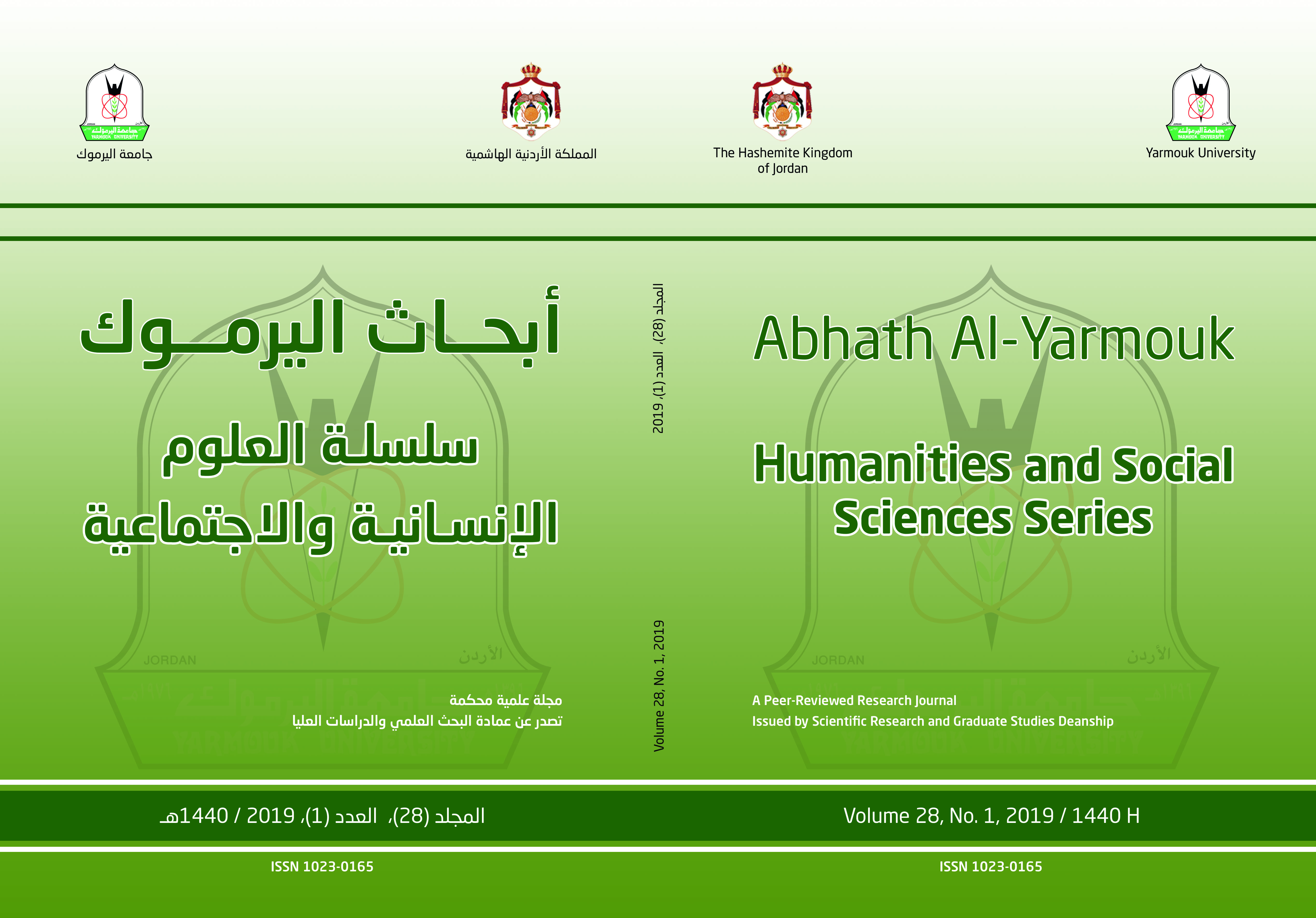تقييم مستويات الجفاف باستخدام مؤشر الحالة النباتية VCI في المناطق الجبلية الوسطى في الأردن
الكلمات المفتاحية:
المرتفعات الوسطى، مؤشر الجفاف VCI، مؤشر النبات OSAVI، نظم المعلومات الجغرافية GIS، الاستشعار عن بعد RSالملخص
هدفت الدراسة إلى تحليل وتقييم مؤشر الحالة النباتية The Vegetation Condition Index (VCI) باعتباره دالة لقياس حالات الجفاف في منطقة شريط المرتفعات في إقليم الوسط في المملكة الأردنية الهاشمية باستخدام تقنيات الاستشعار عن بعد ونظم المعلومات الجغرافية، خلال الفترة 1985-2023 بالاعتماد على بيانات المرئيات الفضائية والمعدلات السنوية للهطول المطري من المجلات المناخية، توصلت الدراسة إلى تناقص مساحة المناطق الخضراء في منطقة الدراسة من 246.9 كم² في عام 1985 إلى حوالي 9.3 كم² في عام 2023، وتباين حالات ومستويات الجفاف خلال الفترة 1985-2023 حيث تراجعت حالة عدم وجود الجفاف تراجعا كبيرا حيث بلغت 2190.7 كم² وبنسبة 93.6 % من منطقة الدراسة في عام 1985 في حين بلغت في في عام 2023 في نهاية فترة الدراسة 150.4 كم² وبنسبة 6.4 % من منطقة الدراسة، وبالتالي حل مكانها حالات الجفاف المتطرف والحاد والمتوسط والخفيف. وأوصت الدراسة بضرورة الاهتمام بالمناطق الخضراء والأراضي الزراعية وخاصة عند وضع السياسات المتعلقة برخص البناء أو من خلال زيادة الوعي لدى المجتمع المحلي، والاهتمام بمشاريع الحصاد المائي.
المراجع
• جاسم شلال و الحسن, عباس و جاسم, عبدالكريم, 2007, استخدام دليل الاختلافات الخضرية الطبيعي (NDVI) في تحديد وتقييم حالة التدهور للغطاء النباتي في منطقة جبل سنجار / محافظة نينوى, المجلةالعراقيةلعلومالأرض،المجلد٧،العدد٢.
• الجمعية العامة للأمم المتحدة, 2013, تسخير الفضاء لأغراض التنمية الزراعية والأمن المائي, تقرير خاص للاجتماع المشترك بين الوكالات بشأن أنشطة الفضاء الخارجي, لجنة استخدام الفضاء الخارجي في الأغراض السلمية.
• شحادة، نعمان, 1990، مناخ الأردن, (ط1), دار البشير, عمّان, الاردن.
• العرود، ابراهيم والبلبيسي، حسام والغنيميين، طارق، 2019، التغيرات المناخية الحديثة وأثرها على الغطاء النباتي في حوض وادي عربة الشمالي المجلة الأردنية للعلوم الاجتماعية، المجلد12، العدد3.
• منظمة الأمم المتحدة للتربية والتعليم (اليونسكو), 2014, الإطار الوطني للإدارة المتكاملة لمخاطر الجفاف, العراق.
• وزارة الزراعة الأردنية, 2023, التقرير السنوي, عمّان, الأردن.
References (Arabic & English)
• Al-Aroud, I. Al-Balbisi, H. Al-Ghunaimeen, T. 2019. Recent climate changes and their impact on vegetation in the northern Wadi Araba Basin, Jordanian Journal of Social Sciences, 12 (3).
• Alhussein, S. 2000. GIS Modeling of land degradation in northern Jordan using satellite imagery, university of Leicester.
• Alito, K. Kerebih, M. 2024. Spatio-temporal assessment of agricultural drought using remote sensing and ground-based data indices in the Northern Ethiopian Highland, Journal of Hydrology: Regional Studies, Volume 52, 101700.
• Cullen, K. 2023, Areview of applications of remote sensing for drought studies in the Andes region, Energy & Resources Group, University of California, Berkeley, USA, Journal of Hydrology: Regional Studies, Volume 49, October 2023, 101483.
• Fern, R. Foxley, E. Bruno, A. Morrison, M. 2018. Suitability of NDVI and OSAVI as estimators of green biomass and coverage in a semi-arid rangeland, Ecological Indicators, Volume 94, Part 1, Pages 16-21.
• Haboudane, D. Miller, J. Tremblay, N. Zarco-Tejada, P. and Dextraze, L. (2002). Integrated narrow-band vegetation indices for prediction of crop chlorophyll content for application to precision agriculture, Remote Sensing of Environment, Volume 81, pp.416- 426.
• Hazaymeh, k. Hassan, Q. 2017. a remote sensing-based agricultural drougt indicator and its implementation over semi-arid region Jordan, article in journal of arid land.
• Jassim, Sh. Al-Hassan, A. Jassim, A. 2007. Using the Natural Differences Vegetative Index (NDVI) in determining and evaluating the state of deterioration of vegetation in the Mount Sinjar region / Nineveh Governorate, Iraqi Journal of Earth Sciences, Volume 7 (2).
• Jordanian Ministry of Agriculture, 2023. annual report, Amman, Jordan.
• Kogan, F. 1995. Application of vegetation index and brightness temperature for drought detection. Advances in Space Research, Volume 15, Issue 11, 1995, Pages 91-100.
• Rondeaux, G. Steven M. and Baret, F. 1996. Optimization of soil-adjusted vegetation indices, Remote Sensing of Environment, 55 (2), pp 95-107.
• Salehi, B. 2017. temperature-vegetation-soil moisture dryness index (TVMDI), article in remote sensing of environment.
• Sameen, M. Alkubaisy, M. (2014). Automatic Surface Temperature Mapping in ArcGIS using Landsat-8 TIRS and ENVI Tools Case Study: Al Habbaniyah Lake, Journal of Environment and Earth Science, Volume 4, No.12.
• Sankey, T. Belmonte, A. Massey, R. Leonard, J. (2020). Regional-scale Forest restoration effects on ecosystem resiliency to drought: a synthesis of vegetation and moisture trends on Google Earth Engine, Remote Sensing in Ecology and Conservation, Volume 7, Issue 2, p259-274.
• Shehadeh, N. 1990. The Climate of Jordan, (1st edition), Dar Al-Bashir, Amman, Jordan.
• United Nations Educational Organization (UNESCO), 2014. National Framework for Integrated Drought Risk Management, Iraq.
• United Nations General Assembly, 2013. Harnessing Space for Agricultural Development and Water Security, Special Report of the Inter-Agency Meeting on Outer Space Activities, Committee on the Peaceful Uses of Outer Space.
• Wu, C. Gonsamo, A. Gough, M. Chen, J. Xu, S. 2014. Modeling growing season phenology in North American forests using seasonal mean vegetation indices from MODIS, Remote Sensing of Environment, Volume 147, Pages 79-88.
• Xiu-Pinga, Z. Rong-Fang, L. Sheng, L. Qun, F. Xiao-Xiao, W. 2011. The Study of Dynamic Monitor of Rice Drought in Jiangxi Province with Remote Sensing, Procedia Environmental Sciences 10 1847–1853.
• Xu, X. Gu, X. Song, X. Li, C. Huang, W. 2010. Assessing rice chlorophyll content with vegetation indices from hyperspectral data, in: D. Li, Y. Chen (Eds.), Computer and Computing Technologies in Agriculture, Advances in Information and Communication Technology, Springer, Berlin, Heidelberg, pp.296–303.
• Xu, Z. Sun, H. Zhang, T. Xu, H. Wu, D. Gao, J. 2023. Evaluating established deep learning methods in constructing integrated remote sensing drought index: A case study in China, Agricultural Water Management, Volume 286, 108405.

